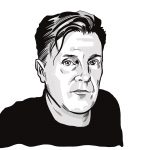Covid-light Australia and New Zealand are facing lockdowns again.
Meanwhile we Europeans are emerging more confidently from enforced or self-imposed isolation, pretending things are almost normal despite the rampant Delta variant.
Vaccinated-up, we stagger blinking into the buzzing blooming confusion of reality. Travelling again on a train, seeing large groups of people, or walking around a big city, for me at least, has taken on a hallucinatory feel.
Something seems wrong, uncanny almost. I struggle to take in what I’m seeing and have a weird distance on it.
This experience reminds me of when I once woke at 2am hearing breaking glass. I thought drunks must have slung a bottle into our drive. I staggered to the front door. It seemed to take seconds to work out what I was seeing.
There was a hand reaching around trying to turn the inside lock – someone had smashed the glass panel next to the door. He withdrew very quickly and ran when I let out an instinctive roar. But so unexpected was the sight of this disembodied hand that I couldn’t understand what it was at first. It was like a scene from a surrealist movie. It could have been a dream. The broken glass and the brick wrapped in a scarf in the hall assured me that it wasn’t.
Most of the time, when not affected by alcohol, other drugs, lack of sleep, late-night burglars, months of isolation, or mental illness, we believe we experience reality directly and more or less as it is. Our senses seem to be windows onto the world. Hallucinations are different.
Hallucinations are when our brains create what we see, like Macbeth with his “Is this a dagger which I see before me?” His mind conjures up the appearance of the object that seems real but when he reaches out to touch it, he can’t.
In a book published this week, Being You – A New Science of Consciousness (Faber), however, neuroscientist Anil Seth argues that there is no clear division between veridical and hallucinatory experience.
The senses aren’t windows. He claims that all perception is all a kind of controlled illusion. The difference between full-on hallucination and what we think of as ordinary seeing is a matter of degree.
Taking his cue from the great Viennese emigré art historian Ernst Gombrich, Seth writes about “the beholder’s share.” Gombrich’s insight was that understanding a picture involves projection. We aren’t passive recipients of light reflected from surfaces producing retinal images which we then process and make sense of.
Rather, our expectations and our ‘mental set’ shape our interpretation of what we see in a picture. When we recognise a field with trees in an impressionist painting we are projecting a landscape into dabs of pigment.
For decades the dominant view in neuroscience was that perception is ‘bottom-up’. Raw information enters via our sense organs (at the bottom of the chain as it were) and is then analysed by different regions of the brain, separating out distinct features of the data, until recognition is achieved.
For Seth, this mostly gets things the wrong way around. He subscribes to a ‘predictive processing’ model of perception in which seeing a tree with its leaves blowing in the wind is best understood as top-down, with our brains making a best guess (from the top) about what is out there, and then revising that repeatedly in the light of incoming information.
We project our expectations onto the world, making inferences about the causes of our experience, constantly updating these to rid them of prediction errors. Our subjective experience of seeing the tree and the changing patterns of dappled sunlight made by the moving leaves is determined by what we infer to be out there.
For Seth, we don’t experience the incoming sensory signals themselves at all, just the interpretations of what is there, our guesses. And that is also what happens with a hallucination. The difference is that what we call normal seeing is controlled by causes in the world, by the information coming in; whereas with more extreme forms of hallucination like Macbeth’s, our perceptions have mostly lost touch with their causes and so aren’t properly refined and updated by the incoming information.
It’s not that there isn’t an objective reality out there. There clearly is. It’s rather that our conscious experience of it is created and interpreted, not straightforwardly delivered to us.
As the philosopher Norwood Russell Hanson wisely observed, there is more to seeing than meets the eyeball. That’s the way it feels now too.



